After all those new world imports*, it’s time to look to a homegrown favourite and a “passion fruit”** of another kind.
Native to South Asia, the brinjal (aubergine, baingan, eggplant or kathirikai – whatever name you know it by, I’ll stick with brinjal for now) does seems to rouse strong passions. I don’t mean its reputation in history for being considered an aphrodisiac (and a cause of madness, too, for good measure)! It’s the extremes of adoration, to active dislike, it seems to evoke in people. Quite often, gastronomic battle lines are drawn in an instant at the mere mention of it. And people display fierce loyalty to regional varieties too. One professional cook I know will not travel out of his village without arming himself with a large bagful of the locally grown variety of brinjal. He is quite forthright in his opinion that “those available in the city are worse than useless“!
The brinjal is cultivated all over India, and scores of varieties of all shapes and hues abound. Karnataka and parts of Andhra Pradesh seem to have a particular fondness for the brinjal. In an interesting account I read on the famed “Mattu Gulla” brinjal grown in Udupi, the author writes of how the reformist seer Sri Vadiraja Tirtha Swamiji is credited with introducing it to the district over 500 years ago, possibly from seeds brought from Bengal. The mattu gulla brinjal is the only variety used in dishes prepared at the Sri Krishna temple in Udupi.
My own progress from brinjal hater to lover has been duly paved with unpleasant encounters. Early memories of picking grisly, grey blobs of disintegrating brinjal out of sambar in boarding school still linger. While serving myself some of my mother’s otherwise delicious moussaka, my spoon would approach the dish at an acute angle, in order to evade the layers of brinjal. I think the only time I came close to liking brinjal as a child was when it was coated in a thick chickpea flour batter and deep fried. But then, batter and deep frying can make most things better!
I’m not quite sure what made it so repugnant to me then, besides poorly executed dishes. If I had to guess, I’d say it was probably exactly what makes it so appealing to me now – the texture. That soft, melting flesh that merged into whatever spices or sauce it was cooked with seemed so pointless to me back then. Now of course I see just how amazingly versatile that makes it. Though some carnivores may disagree, there is definitely a “meatiness” to the brinjal.
As if to underline that quality, last month, when I was in India, my cousin Asha dropped by on a visit, and handed me a dish of something that looked like yerchi barthad (dry fried meat). I thought I was looking at glossy chunks of meat, covered in a spicy masala paste. I then did a double take – it was actually bainé barthad (fried brinjal) made with small green brinjals grown on her farm. It was simply spiced, so the delicacy of the brinjal wasn’t lost, but big on flavour, with a lovely, caramelized touch to the coconut. It was utterly delicious!
Asha is one of those naturally gifted cooks who don’t need a recipe to turn out perfect dishes. Based on her description, I’ve tried to replicate it here in Vancouver, using locally available eggplants. It’s not nearly as good as what she made, but I’m still really pleased with the result!
Thank you for sharing, Asha. 🙂
* Please see parangi malu, goomatté pann, passion fruit, pineapple, and avocado.
** Botanically speaking, the brinjal is a fruit.
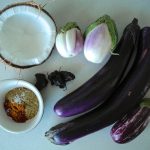
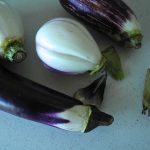
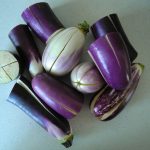
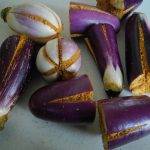
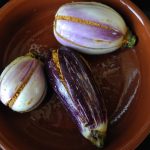
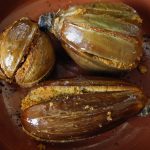
Asha’s Bainé Barthad
Stuffed fried brinjal/eggplant
- 1/2 kg brinjal, preferably a thin skinned variety
Grind together to a coarse paste:
- 1 1/2 cups freshly grated coconut
- 1 tbsp ground coriander
- 1 –1 1/2 tsp red chilli powder
- 1/2 tsp turmeric
- 1 tbsp tamarind paste
- 1 tbsp jaggery
- Salt to taste
- 2-3 tbsp oil (untoasted sesame oil, or peanut oil are good choices here)
This quantity of oil will give you a drier finished dish. If you want a more luxurious dish, feel free to use more oil. Brinjal loves oil and will happily drink whatever you send its way!
Trim the brinjal, leaving the stems intact. Score a deep cross into the flesh, going about 2/3 of the way through.
Spoon the coconut and spice mixture into the cuts and press in firmly.
Heat the oil in a wide, shallow pan and put in the brinjal, carefully moving them around to brown the outsides.
Cover and cook on medium low for a few minutes, then cook uncovered until tender.( If there is any coconut mixture left over, add it now and continue cooking.)
This recipe works well with the thin skinned japanese eggplants available here. Cut them into 3-4″ lengths, then score about halfway through before stuffing.
If you’re using the denser fleshed variety of eggplant, you could try baking them instead. Brush with oil and bake at 350 F for 15 minutes until the skin turns brown.Then cover and bake for another 30 minutes.
Finish by cooking them uncovered for another 10-15 minutes, or until done.
Asha’s notes: The coconut mixture should not be ground too fine. To help prevent the brinjal from absorbing too much oil, keep the heat on high initially, until the skin is lightly browned.

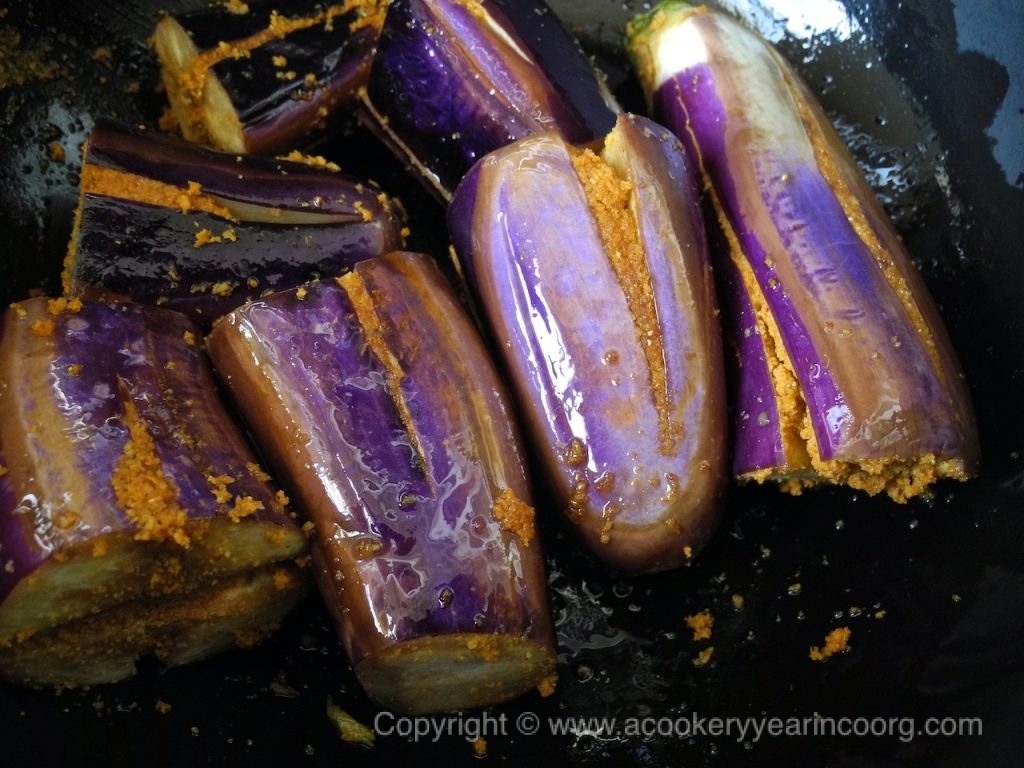
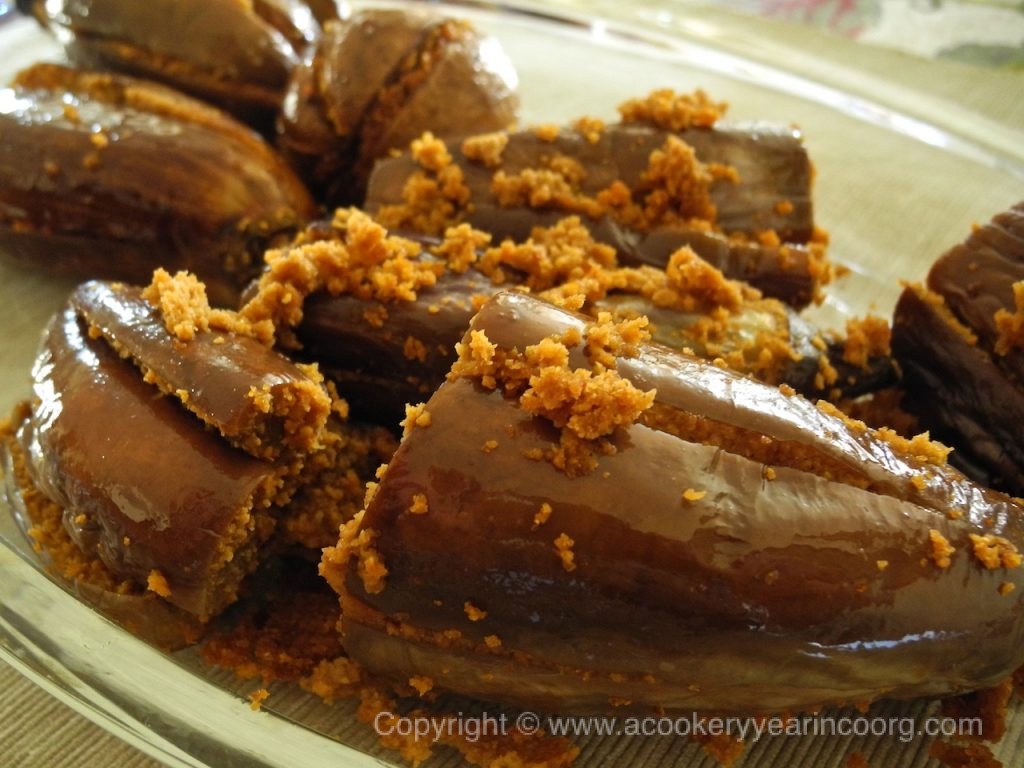
Oooh – I AM going to make this on the weekend!
Did you make it, Kay? Ask your veggie man to get you those small brinjals. 🙂